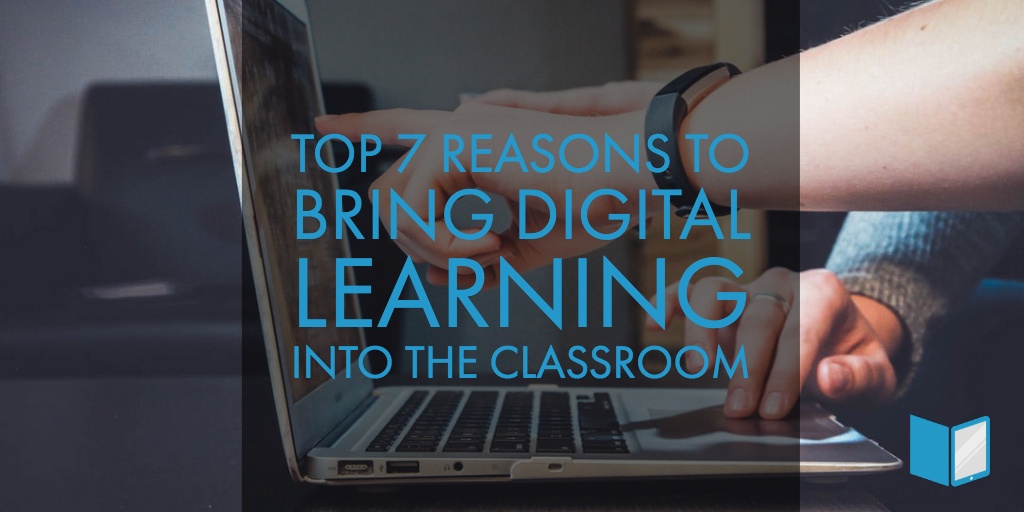It’s 2018. Each successive generation grows up with more and more familiarity with technology. Few children have not used an iPad, smartphone, or computer. While excessive screen time can be harmful, the technology we have today also opens up a vast plane of possibilities. Studying can now mean more than pouring over a dull, outdated textbook or running through handmade flashcards. Learning can be more interactive and engaging than ever before, and it can happen anywhere. Best of all? It WORKS. These are just a few of the countless reasons every classroom should include elements of digital learning.
1. Customized Education
Like snowflakes, no student is the same. Every learner works at a different pace. What works for one student might fall flat for the next. Teachers do their best to provide the best learning opportunities for every student, but in a large classroom it’s impossible to cater to varying skill levels and learning styles. Alternatively, digital learning can be tailored to fit individual students’ needs. This doesn’t replace the need for experienced educators. Rather, it provides an additional tool to help teachers increase classroom productivity and reach as many of their students as possible.
2. Improved Engagement and Self-Motivation
When it comes to educational success, self-motivation matters. If students aren’t engaged, teachers can lecture until they’re blue in the face without seeing any improvement in test scores. Digital learning can provide a learning environment that feels more like a game than a study session. Do you remember opening a history textbook and realizing at the end of the first chapter that you zoned out on page 3? Digital learning eliminates that common struggle. Students are required to actively participate in their education. Interactive elements encourage active learning habits and reinforces knowledge acquired through reading and lectures to provide a complete educational package.
3. Constant Feedback
Imagine you’re at the gym. There are two treadmills. One treadmill has a few buttons to adjust speed and incline, and that’s it. The other? It has a digital panel tracking heart rate, calories burned, and multiple options for designing your own workout. Which would you choose? For most people, there’s no contest. When people have visual feedback of their progress and achievements, motivation effortlessly rises. This applies to education as well. Digital learning offers students constant feedback- where they excel, what they need to work on, and a sense of accomplishment when they succeed. They can progress at their own speed, and teachers know immediately when a student needs extra assistance or academic intervention.
4. Smarter Students
Smarter tools mean smarter students. Textbook learning often results in temporary memorization. Online learning encourages students to develop research skills, solve problems, and gives instant feedback. This increases productivity and learning efficiency. Additionally, technology can boost critical thinking skills by engaging students in active problem solving and decision making. The heightened sense of accomplishment from instant feedback builds confidence in their skills, leading to faster learning and increased academic performance.
5. Relevant, Updated Content
In past years, textbooks were often used repeatedly even if the information inside was outdated. Digital learning enables publishers and educators to update content at any time. The more the content applies to modern life, the easier the modern learner absorbs the information. With online learning, students can access relevant, updated material and new learning activities with ease.
6. Diverse Opportunities
The stand out benefit of digital learning is the opportunity to learn anytime, anywhere. From kindergarten through advanced degree programs, students can take their education with them on the go. Digital learning can shapeshift to fit a wide-range of schedules, with no tools required other than a compatible device and internet access. Courses can be accessed in between work shifts, around after school activities, and around the world. In short, students no longer have to put their lives on hold to get an education.
7. Increased Connections
Developing a network of personal and professional connections is essential for success. Digital learning offers students the ability to connect with their peers not just nationally, but globally. Similarly, educators can connect with each other to share ideas, activities, and teaching techniques like never before.
For now, traditional educational methods still have a place within modern education. The possibilities offered by digital learning, however, are endless. At the very least, they increase academic achievement, student motivation, and diversify learning opportunities. While teachers are irreplaceable, pairing them with advanced, digital learning programs creates a dynamic duo. The result? Unprecedented levels of engagement and student success. When digital learning enters the classroom, everyone wins.
A remarkable simple software solution comes in the form of Gutenberg Technology’s MyEcontentFactory (MEF) that enable publishers to focus on a digital-first process that works seamlessly with the print option that follows.
More than 20 educational companies and publishers are using MEF software already, including Cengage Learning.






Leave a comment